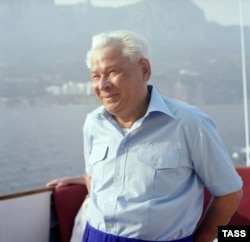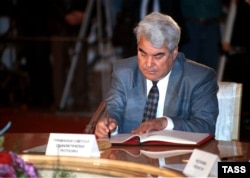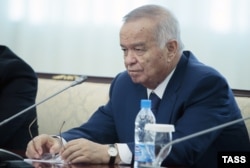You're part of the elite governing an authoritarian regime. The regime's titular leader is ailing, possibly on death's door. Who's going to succeed him is an open question. What's a regime to do?
This question was raised recently when the fate of Turkmen President Gurbanguly Berdymukhammedov was shrouded in rumor, confusion, and official obfuscation. The fevered speculation of his death was put to rest on August 12 when he appeared as the host of the Caspian Economic Forum and met with several government leaders.
But his disappearance from public appearances and national television -- where his presence to the Turkmen people each night was a virtual certainty -- led many to recall the 2006 death of his predecessor, Saparmurat Niyazov.
Calling himself Turkmenbashi (Father of all Turkmen), Niyazov's disappearance and eventual death was clouded in uncertainty.
So was that of Islam Karimov, the longtime leader of neighboring Uzbekistan, in 2016.
It was also true for the deaths of Soviet leaders Andropov, Chernenko, Brezhnev, and even, to some degree, Stalin.
In the post-Soviet era, just as when the Soviet Union existed, it's a fraught process trying to figure out how to announce an authoritarian leader's death. If it's not managed properly, it could undermine how a country's citizenry, and the world, perceive the leader and sow doubts about a regime's viability. That goes double if the question of who the next leader will be is up in the air, as is often the case in authoritarian countries.
Josef Stalin (1953)
Arguably, the death of Stalin was where the textbook on how to stage-manage authoritarian-regime death rituals in the 20th century was written. Sure, kings, queens, and emperors of centuries past were also shuffled off into the afterlife with elaborate rituals. But the 20th century was the era of mass communications, with domestic and international audiences that had be communicated to -- or manipulated.
In Stalin's case, the Communist Party of the Soviet Union, itself molded by his leadership, had constructed what was later called a "cult of personality" around Stalin. For many Soviet citizens, he was a semi-deity who, among other things, led the country to triumph over Nazi Germany.
On March 1, 1953, he was found unconscious on the floor of his dacha in a Moscow suburb, having suffered a cerebral hemorrhage. Doctors -- who were terrified by the ongoing crackdown known as the Doctors' Plot that targeted "saboteur-doctors" who purportedly were trying to assassinate top officials – were reluctant to treat him aggressively and he spent the next three days on a couch at the dacha.
At around dawn on March 4, Radio Moscow issued the first news report on Stalin's condition, stating that he had suffered a stroke and was partially paralyzed. The report also said he was undergoing medical treatment, suggesting that recovery might be possible.
On March 5, at 9:20 p.m., Stalin died. The next morning, in the pre-dawn hours, the hammer-and-sickle flag above the Kremlin was lowered to half-staff, and state media announced his death.
The party's official newspaper, Pravda, published a eulogy that paid homage to Soviet founder Vladimir Lenin. And in a nod to fears that Stalin's death would undermine the Communist Party's iron grip on power, the announcement also asserted the "steel-like and monolithic unity of the ranks of the party."
"The immortal name of Stalin will live forever in the hearts of the Soviet people and all progressive mankind," the eulogy continued. "Long live the great and all-conquering teachings of Marx, Engels, Lenin, and Stalin! Long live our mighty socialist motherland! Long live our heroic Soviet people! Long live the great Communist Party of the Soviet Union!"
Stalin left no instructions about the succession. The day of his death, leading Politburo members including Georgy Malenkov, Lavrenty Beria, Vyacheslav Molotov, Nikita Khrushchev, and others met to create a fragile structure of "collective leadership," with Malenkov anointed as "the first among equals."
The struggle continued behind the scenes until September, when Khrushchev emerged as the next clear leader of the Soviet Union.
Leonid Brezhnev (1982)/Yury Andropov (1984)/Konstantin Chernenko (1985)
The death of Leonid Brezhnev in 1982 was the first in a spate of deaths of Soviet leaders, something that raised questions about the viability of the Soviet leadership, not to mention lots of darkly humorous jokes.
At 75, Brezhnev was ailing for much of the final year of his life, rarely making public appearances. The communist leadership repeatedly denied rumors of his ill health.
On the evening of November 10, state television began shuffling its regular programming, with one channel broadcasting a documentary about Vladimir Lenin and another showing a performance of a Tchaikovsky symphony. Later, the beloved ballet Swan Lake was shown in its three-hour entirety.
At 11 a.m. Moscow time, Soviet television and radio officially announced Brezhnev's death; the well-known television anchor and host of the flagship Vremya news program, Ivan Kirillov, read the announcement, reportedly with tears in his eyes.
Later reports emerged that Brezhnev had suffered a stroke in May. It also turned out that Brezhnev had refused to turn over his authority to a successor even on his death bed.
Brezhnev was succeeded by KGB chief Yury Andropov, who was already known as a chain smoker with serious health issues. Andropov's ill health led to kidney problems, and he was hospitalized in August 1983.
Those details were closely guarded and not released publicly until after his death, which fueled new questions about succession procedures for the Soviet leadership.
Andropov ultimately died on the afternoon of February 9, 1984, at the age of 70. Hours before the official announcement came, radio and television programs began playing what was described as melancholy classical music. Swan Lake also made another appearance.
The official announcement, which was also read by Kirillov, said Andropov died "after a long illness," with complications from diabetes and hypertension.
Andropov's successor, Konstantin Chernenko, lasted even less time as Soviet leader than Andropov, serving only 13 months. Like Andropov, Chernenko was a chain smoker with chronic health problems. Much of his time in power was spent receiving medical treatment for emphysema and other pulmonary issues. As with his predecessors, those problems were largely kept from public view.
On February 22, 1985, a sickly looking Chernenko was shown at a televised rally in Moscow, and he appeared on state television six days later extolling the results of a local election. Kremlinologists speculated he was not long for this world.
On March 10, Swan Lake was shown yet again on the main state television channel. Chernenko died after falling into a coma. A somber Kirillov again read out the official Politburo announcement, the third time he had done so in three years.
The fact that Swan Lake was associated with the deaths of Soviet leaders had an unintended consequence years later for Chernenko's successor, Mikhail Gorbachev.
In 1991, when a group of hard-line officials tried to oust Gorbachev in a coup, regular state television programming was taken off the air and replaced with a looped broadcast of the ballet.
Many Russians thought Gorbachev had died.
Saparmurat Niyazov (2006)
Like his successor Berdymukhammedov, Niyazov was as eccentric as he was dictatorial. During his 21 years in power, he led Turkmenistan into isolation, even as he sought to exploit the country's vast natural-gas wealth.
Like Stalin, Niyazov built up a cult of personality. He renamed the month of January after himself and April after his mother, among other similar changes. He made his writings mandatory reading for schoolchildren and installed a giant golden statue of himself in the capital, Ashgabat, that rotated to always face the sun.
In the very early morning hours of December 21, 2006, Turkmen state television reported that Niyazov, the self-styled "Father Of All Turkmen," had died of a heart attack at the age of 66.
"It has been decided that our great leader will be buried on Sunday, December 24," a television announcer said. "Seven days of mourning have been announced for our great leader."
Later the same day, there was an announcement that Gurbanguly Berdymukhammedov, who had been deputy prime minister and health minister, had been named acting head of state and would head up the commission overseeing funeral ceremonies for Niyazov.
No details, meanwhile, were given as to how Berdymukhammedov was selected, one of several ambiguities that characterized the process.
In fact, Ovezgeldy Atayev, the chairman of the Assembly of Turkmenistan, was supposed to be named acting president, according to the constitution.
But instead it was announced that criminal proceedings had been begun against him and he was soon imprisoned, clearing the way for Berdymukhammedov to become president.
The speed of the Berdymukhammedov appointments so quickly after the announcement of Niyazov's death led many observers to speculate that Niyazov may have died some time -- possibly several days -- before the official announcement.
Throughout the day, state television broadcast Niyazov's portrait while melancholy piano music by a well-known Turkmen classical composer played in the background. Later, the sounds of wailing women were heard as the portrait was shown. Still later, young Turkmen men and women were shown wearing black and reading Niyazov's writings.
Islam Karimov (2016)
When Islam Karimov's death was announced on September 2, 2016, the 78-year-old was the second longest-serving leader in the former Soviet Union, having ruled Uzbekistan with dictatorial power for 27 years.
As it later turned out, Karimov had been first hospitalized in serious condition six days earlier, on August 27-- something that didn't fully come to light until after his death.
On the day he was hospitalized, the first rumors appeared courtesy of the independent Central Asian news site Fergana.ru. Moreover, the site reported that Karimov was not hospitalized, but had, in fact, had a major stroke and had died -- something that was never independently verified.
A day later, on August 28, the Foreign Ministry issued a statement confirming Karimov was receiving medical treatment, a highly unusual admission by an official government agency.
Writing on Facebook, his younger daughter, Lola, later confirmed that Karimov was in stable condition.
In its nightly newscast on August 29, state-run television made no mention of Karimov's condition.
On August 31, Lola Karimova published another post on Facebook saying that her father might be recovering, an indication that at that time, he was still alive. Lola followed up with another post the following day with a plea for Uzbeks not to speculate about her father's condition.
Finally, in the early hours of September 2, the Reuters news agency, citing unnamed diplomatic sources, said Karimov had died. Turkey's prime minister said during a televised cabinet meeting the same day that the Turkish people "shared the Uzbek people's pain and suffering."
On state television, the tone of reporting on Karimov's health turned more serious, with announcements stating he was gravely ill, confirming Lola's Facebook posts.
At around 10 p.m. local time, state television finally reported his death.
In the official medical report that was released shortly thereafter, officials revealed that Karimov had in fact been hospitalized on August 27 -- two days before reports initially emerged -- and that he had suffered a stroke and cardiac arrest. That stoked speculation that Karimov may have been clinically dead as early as August 27 and was being kept alive artificially.
Uzbek state television also ran segments that focused on the grave being prepared for Karimov in his hometown of Samarkand. According to the television reports, among those helping dig the grave was Shavkhat Mirziyoev, who ultimately succeeded Karimov as president.



















